List of Contents
What is the Corporate Wellness Market Size?
The global corporate wellness market size is calculated at USD 68.02 billion in 2025 and is predicted to increase from USD 72.73 billion in 2026 to approximately USD 129.44 billion by 2034, expanding at a CAGR of 7.41% from 2025 to 2034.
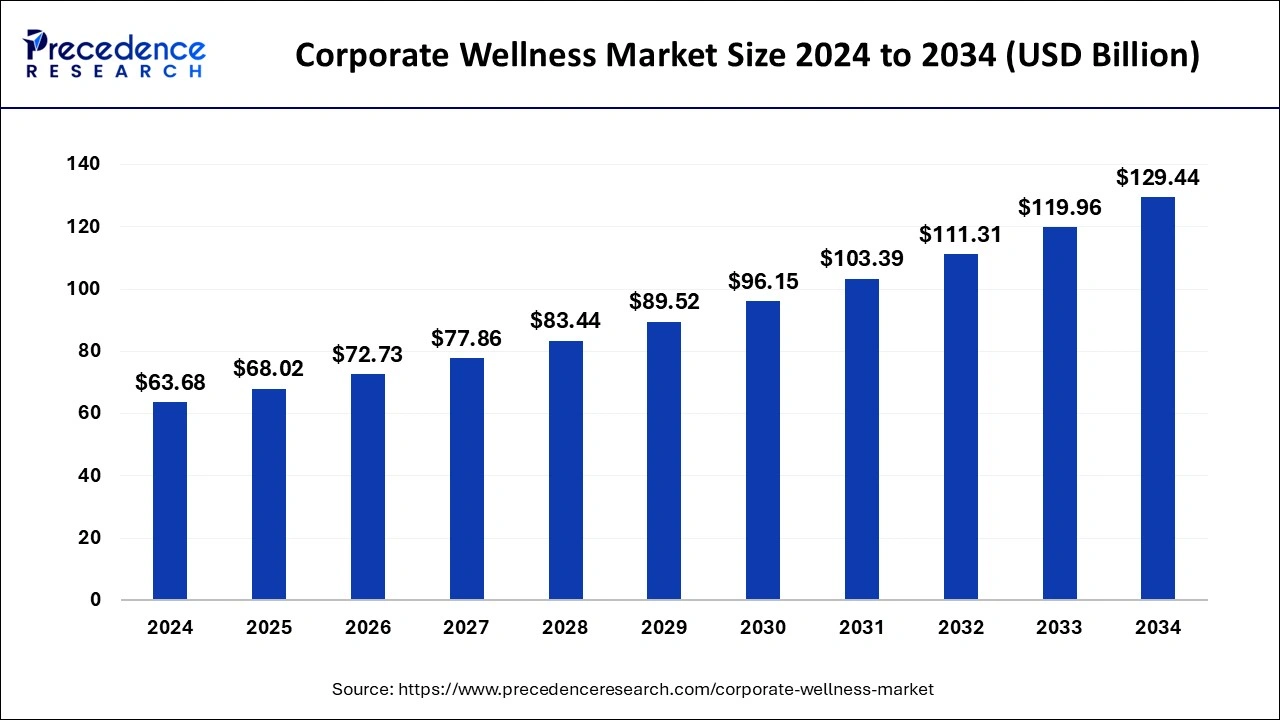
Corporate Wellness MarketKey Takeaways
- North America contributed more than 40.30% of the revenue share in 2024.
- Asia Pacific region is estimated to expand the fastest CAGR between 2025 and 2034.
- By Service, the health risk assessment segment has held the largest market share of 21.48% in 2024.
- By Category, the organizations/employers segment captured the biggest revenue share of 50.37% in 2024.
- By Delivery Model, the onsite segment generated over 60.50% of revenue share in 2024.
- By End-use, the large-scale organizations segment is estimated to hold the highest market share of 63.92% in 2024.
What is Corporate Wellness?
Several industries and companies have started heath programs for their employees that are expected to boost the market growth of corporate wellness in the coming years. These programs help companies to augment their productivity by reducing the overall operational cost. Further, rising awareness for the health benefits and wellness of the employees also projected to drive the market growth significantly over the forecast period.
Through wellness programs both employee and employer can gain high benefits. As presently, people prefer those workplaces that have good work culture as well as health improvement plans expect of daily task. Health awareness or improvement programs impact positively on the organizational environment and culture. In addition, employees also prefer to adopt incentive-based wellness activities as they play a significant role in employee's motivation.
How is AI helping the Corporate Wellness Industry?
Artificial intelligence in corporate wellness includes meal plans and schedules, diet analysis, real-time stress reduction, individualized guided meditation, AI therapist chatbot, real-time health tracking & holistic monitoring, AI coaching, and early detection. AI is proving itself as a powerful tool to diagnose disease, protect aging populations, and provide assistive technologies to disabled communities. AI helps by giving each employee advice that fits their needs. It watches for early signs of stress or health risks using wearables, surveys, and work patterns data.
AI can be used to support digital communications, offering schedule reminders, tailored health tips and suggested next steps to patients. Artificial intelligence and generative AI have the potential to transform how strategists work by strengthening and accelerating activities like analysis and insight generation while reducing challenges posed by human biases and the social side of strategy. Recent research demonstrated the potential of AI-assisted interventions in reducing stress and burnout, especially in high pressure profession.
- In June 2025, the launch of groundbreaking AI-driven corporate wellness solution redefining the future of employee health, wellness, and performance was launched by MAXIOM, the world's most precise and reliable health and performance AI platform.
Corporate Wellness Market Outlook
- Industry Growth Overview: Between 2025 and 2030, this market is expected to grow significantly due to the rising incidences of anxiety and stress among corporate workers coupled with rapid adoption of modern therapies among employees for managing stress level.
- Major Investors:Several healthcare companies and strategic investors are actively entering this market, drawn by collaborations, R&D and awareness programs. Various market players such as Privia Health, Central Corporate Wellness, Wellsource, Inc., SOL Wellness, Truworth Wellness and some others have started investing rapidly for opening new therapy centers in different parts of the world.
- Startup Ecosystem:Numerous startup brands are engaged in providing mental wellness solutions to corporate employees. The prominent startup brands dealing in corporate wellness consists of Wellable, VantageFit, Headspace and some others.
Corporate Wellness Market Trends
- Growing awareness about health and productivity relations and how they affect every aspect of the area. In today's era, the corporate world is increasingly understanding the direct link between productivity ratio and employee health status. Hence, more companies are heavily investing in comprehensive wellness programs, including mental health programs, routine health checkups, and stress management sessions, while aiming to offer a healthier workplace.
- Increasing cases of chronic diseases like cardiovascular disease, morbid obesity, and other critical health issues are another factor fueling the corporate wellness market. Chronic illness can cause higher medical expenses for employees. By knowing this, many companies offer medical claims, sick leaves, and other preventive care programs, helping the market to grow on a large scale.
- Another significant factor for the corporate wellness market is the integration of innovative technologies with wellness programs to increase their efficiency, accelerating the market further. Many devices, like wearable healthcare devices, monitoring applications, and smartwatches, are becoming an integral part of corporate wellness programs and are accepted by a number of employees across various sectors.
- The growing prevalence of remote work and increasing demand for virtual wellness solutions to offer support for employees working remotely from any location. To achieve this, many companies are adopting various techniques and platforms to offer fitness knowledge, digital health basics, and mental health regulation, aiming to provide personalized solutions for every individual. I include methods to follow work-life balance and how to handle isolation and fatigue due to overwork.
Market Scope
| Report Highlights | Details |
| Market Size in 2025 | USD 68.02 Billion |
| Market Size in 2026 | USD 72.73 Billion |
| Market Size by 2034 | USD 129.44 Billion |
| Growth Rate from 2025 to 2034 | CAGR of 7.41% |
| Base Year | 2024 |
| Forecast Period | 2025 to 2034 |
| Segments Covered | Service, Category, Delivery Model, End-use |
| Regional Scope | North America, Europe, Asia Pacific, Rest of the World |
Market Dynamics
Drivers
Longer working hours and a longer life expectancy
There are various crucial factors which affect the market and lead to upward movement of corporate wellness sector. They are significant for holistic approach that means for employees and employers to bring out the optimum output and maintain the well-being of the work culture. With the growing competition and to withstand in the business world, the employees have to devote longer working hours which demands healthy and longer life expectancy of them. In order to maintain the efficiency and well-being of the employees, the organisation opts for various wellness programs and policies which ultimately bolster the corporate wellness market.
Growing awareness about stress and prevalence of chronic diseases
The working-class population has become workaholic and occupied that they tend to take stress and fails to manage things in life which adversely affects the physical and mental health. The increased depression and stress have created the need for behavioral and mental health management of the employees which resulted in demand for wellness programs by the organisations for its employees. Therefore, this propels the market growth and serves as the key purpose for the demand of the health products and services.
A Big Change in Well-Being Attitudes
A modern sense of belonging linked to fitness which is deeply prized in contemporary society is opening new doors. As a result of digitalization, which is pushing global market expansion, customers are looking for ways to detox from their digital frenzy and regain their time for personal advancement, harmony, and fitness. Various practices are followed namely meditation, yoga, stress relieving programs, detoxifying challenges to boost the immunity by the target audience for the fitness and health concerns. Therefore, the growing concern for health and changing attitude towards health is driving the market.
Rising dominance of Artificial Intelligence
The global corporate wellness market will be transformed by the arrival of a new age of personalized education and solutions that cater to each employee's individualized well-being through AI. Several companies are turning to artificial intelligence to maintain employee interaction between human touch points, create a more detailed profile of their workers in real time and help them scale up their wellness plans without relying heavily on human resources. AI-enabled services recognize patterns, predict how real health problems or statistics will play out in the future, and devise a strategy to keep illnesses and other health and well-being issues. Hence, it is significant factor for the market growth.
Restraints
Dearth of qualified and skilled professionals
According to the Health Resources and Services Administration, the number of adult psychiatrists in the United States is expected to drop by 20% by 2030. The shrinking number of fresh experts entering these professions is the key reason for the shortage of qualified and skilled professionals. In emerging countries, the shortage of mental health experts and other professionals suitable for corporate wellness programs is much more apparent. For instance, In India, there are just 0.75 psychiatrists per 100,000 inhabitants. This scarcity of appropriately skilled personnel obstructs the ability to launch and manage effective, holistic corporate wellness programs, thus limiting the market's growth especially in the developing economies.
Budgetary Constraints
The occupational health policies involve huge cost for the various health and wellness programs. Sometimes, companies set up gyms which require regular maintenance of Equipment and high payment to the professionals and trainers, which add to the operational cost of the organization. This leads to the overall cost of the organization and mostly the huge workplace cost has to be borne by the organization which are the key factor hindering the market growth of corporate wellness programs. This is even more common in medium and small scale organizations.
According to a research, nearly half of employers believe that cost assumptions regarding workplace wellness programs are the most significant barriers to employee happiness. It requires money to buy plants to improve the workplace environment or to organize an event for employee well-being. Despite the fact that studies show that investing in employee health programs can yield a return of $3 to $4 for every dollar spent, many businesses may not have the financial resources to make the first commitment.
Low awareness regarding the corporate wellness programs
According to numerous studies, a communication gap is the primary reason why many employees are unaware of their company's health programs. Even if they are aware that such programs exist at their place of business, many are unaware of the benefits or other aspects, and hence have little interest in participating or engaging in them. While some employees may lack the necessary drive to make beneficial changes, others may just be unwilling to change. Employers must provide employees with all of the specifics and pertinent information about corporate wellness programs in order to ensure that they step outside of their comfort zone. Employees must be informed about the purpose, aims, and potential rewards, and they must be encouraged to participate. Offering incentives and awards can help entice people to participate. Employees are very likely to continue after they observe the good changes and benefits. Therefore, lack of awareness regarding the corporate wellness programs restricts the market growth to certain extent.
High cost involved
The occupational health policies involve huge cost for the various health policies and wellness programs. Sometimes, companies set up gyms which requires regular maintenance of Equipments and needs to handful of fees to the trainers which adds to the operational cost of the organisation. This leads to the overall cost of the organisation and mostly the huge workplace cost has to be borne by the organisation which are the key factor hindering the market growth of corporate wellness programs.
Stringent regulatory requirements
The regulatory authorities of several nations have jotted stringent regulations for the commercialization of services. There are chances of different regulation by Government and Organizations towards employee having multiple business locations. This will affect standardization of the services. Also, the operational hurdles posed by the service industry and large number of employees decelerates the growth of the market.
Opportunities
The focus on workforce health is becoming more prominent globally.
Companies now days are focusing towards employee's health and make sure their employees are healthy. According to the CDC, six out of ten persons in the US have a chronic disease (e.g., stress, lung disease, stroke, Alzheimer's, diabetes, renal disease), and four out of ten have two or more disorders.
The figures on health-care costs are staggering:
- Stress accounts for 37% of all work-related illness and 45% of sick days (Towers Watson).
- Heart disease and stroke cost $126 billion in lost productivity each year (American Heart Association).
- One in seven dollars of healthcare is spent on diabetes (American Diabetes Association).
- Alzheimer's alone costs U.S. businesses $61 billion per year (Alzheimer's Association).
- More than 11 million Australians have at least one of eight chronic diseases.
- Healthcare costs in the European Union currently make up between 7% and 11% of overall GDP expenditure
- Cardiovascular disease contributes to one out of three deaths in Singapore.
- In Europe, 28% of adults smoke.
These expenditures can be drastically lowered if employees are encouraged to focus on developing better daily routines and lives. Taking the stairs, drinking less soda, getting more sleep, and minimizing stress at work are all habits we can develop, and the behavioral changes that occur can have a good impact on our job.
For instance, Virgin Pulse's daily engagement platform can motivate customers to do things like meditate every morning, take the stairs, drink more water, eat healthier meals, and save money. By applying these tools, thousands of firms using Virgin Pulse's program have witnessed a 16 percent reduction in healthcare claim costs per member, on an average. Therefore, to determine where the population's problems and opportunities are, as well as the financial and health benefits that may be achieved by addressing them through corporate wellness programs offer lucrative opportunities for the market growth.
Service Insights
- In February 2025, to help manufacturers and safeguard users was launched by Digital mental health technologies guidance to help manufacturers meet UK medical devices regulations and ensure digital mental health technologies are effective, reliable, and acceptably safe.
- In October 2024, an initiative for stress management and work life balance was launched by ICAI (Institute of Chartered Accounts of India) forms dedicated group. ICAI will continue offering workshops and webinars promoting physical activity and mindfulness to support professionals in balancing work and personal life.
Global Corporate Wellness Market, By Service, 2024 (%)
| Service Segment | 2024 (%) |
| Fitness | 14.64% |
| Health Risk Assessment | 21.48% |
| Health Screening | 6.66% |
| Smoking Cessation | 15.81% |
| Stress Management | 13.26% |
| Nutrition & Weight Management | 18.11% |
| Others | 10.04% |
Category Insights
- In July 2025, a new digital media platform, NaturalPeptidesForWeightLoss.Com was officially launched responding to the rising demand for clear evidence-based information about fitness, wellness, and weight management. This website offers independent reporting, expert analysis, and data-driven insights for readers seeking trustworthy knowledge in an increasingly crowded digital landscape.
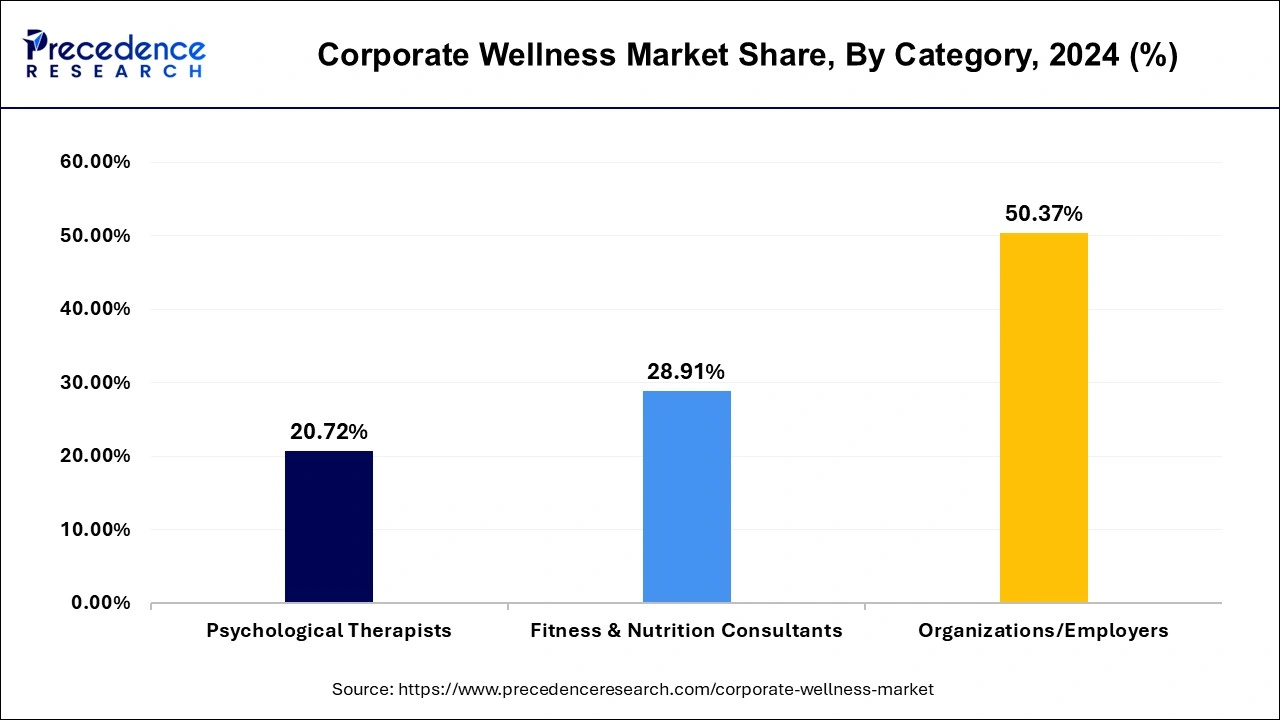
Delivery Model Insights
- In April 2025, the opening of second innovative Plane Healthy Wellness Center & Pharmacy, in Wichita, Kansas was announced by Textron Aviation Inc.
End-use Insights
- In October 2024, Advantage Wellness, India's first comprehensive employee wellness marketplace was launched by AdvantageClub.ai, a prominent global AI-driven platform specializing in employee engagement and flexible benefits.
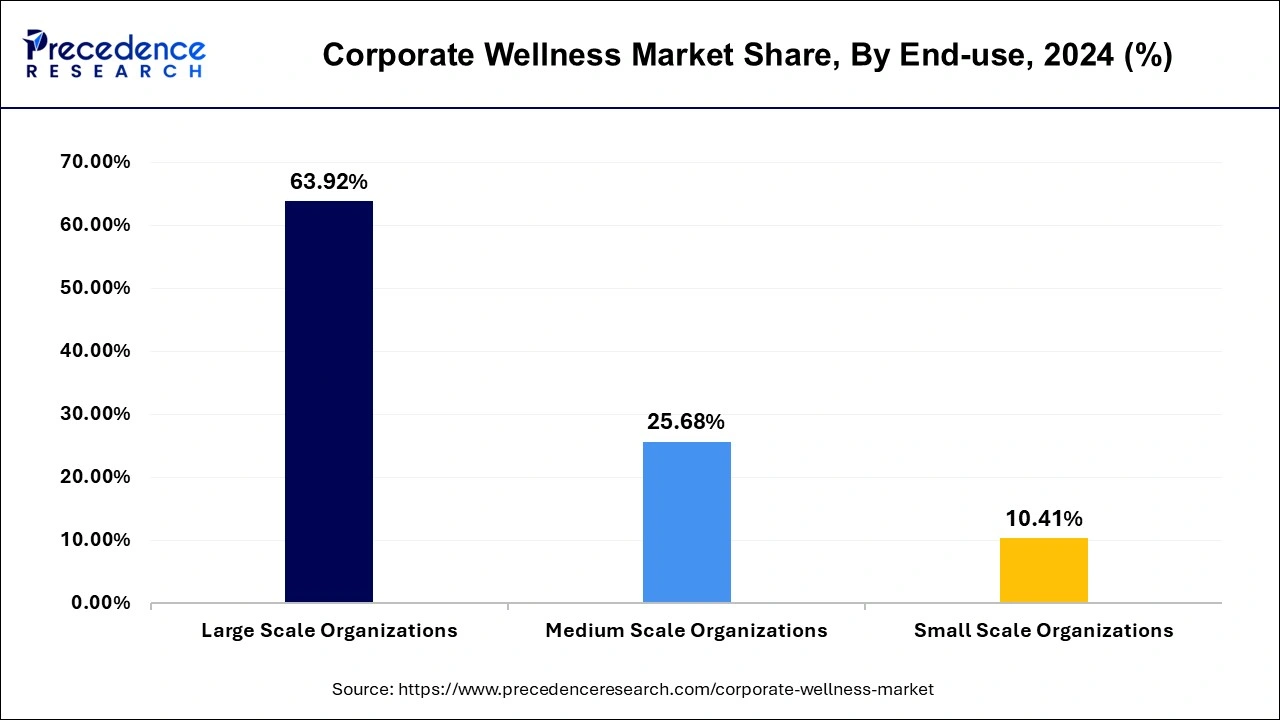
Regional Insights
U.S. Corporate Wellness Market Size and Growth 2025 to 2034
The U.S. corporate wellness market size is exhibited at USD 23.38 billion in 2024 and is projected to be worth around USD 42.11 billion by 2034, growing at a CAGR of 6.76% from 2025 to 2034.
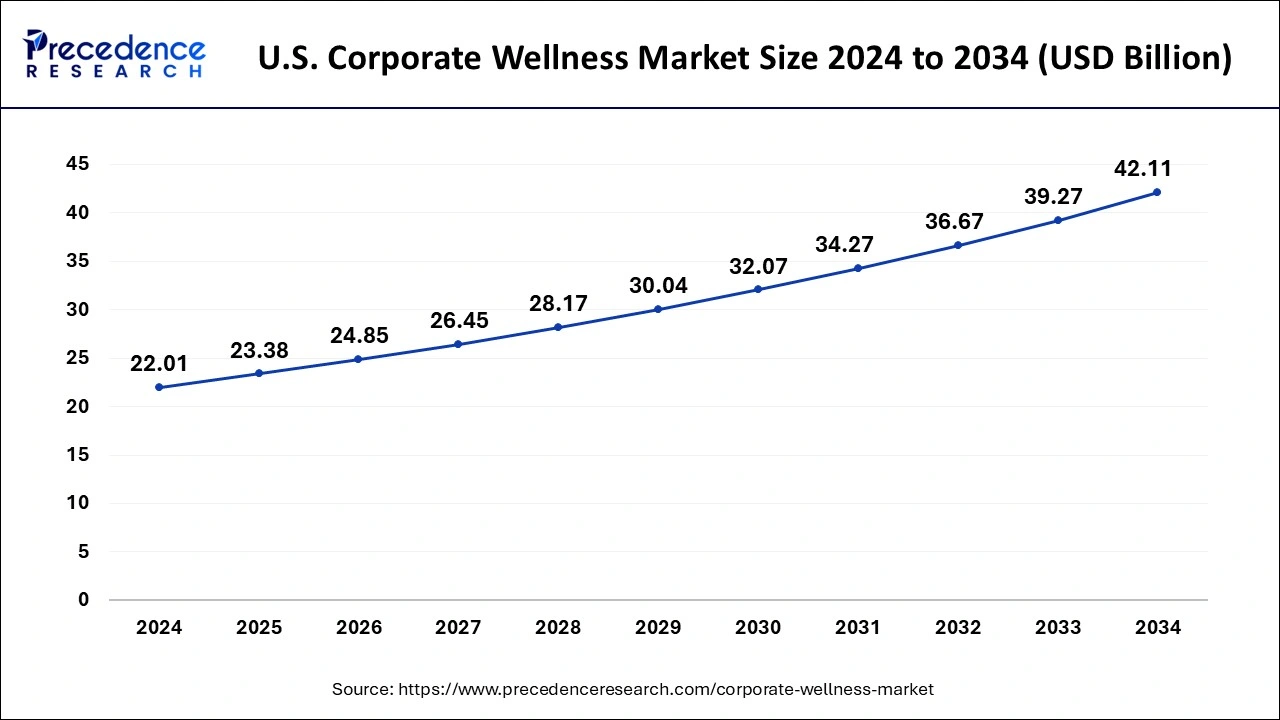
North America emerged as the global leader in the corporate wellness market in terms of revenue share in the year 2024. As per RAND employer survey, nearly 50% of the corporate owners in the U.S. provide wellness programs to their employees inside their organization. In addition, significant dominance of the office culture in the North America influence the corporate owners in the region to implement such services or programs to benefit their employees with good health.
However, the Asia Pacific witness flourishing growth at a CAGR of 9.30% over the forecast period owing to prominent rise in the working population along with increasing awareness regarding health management of employees. A large workforce in a growing economy has a better chance of attracting wellness market growth in the coming years. The market is rapidly gaining traction in the region, and many businesses have begun to invest in it because of its value to employees. The potential for further adoption in the region is enormous thereby contributing to the market growth.
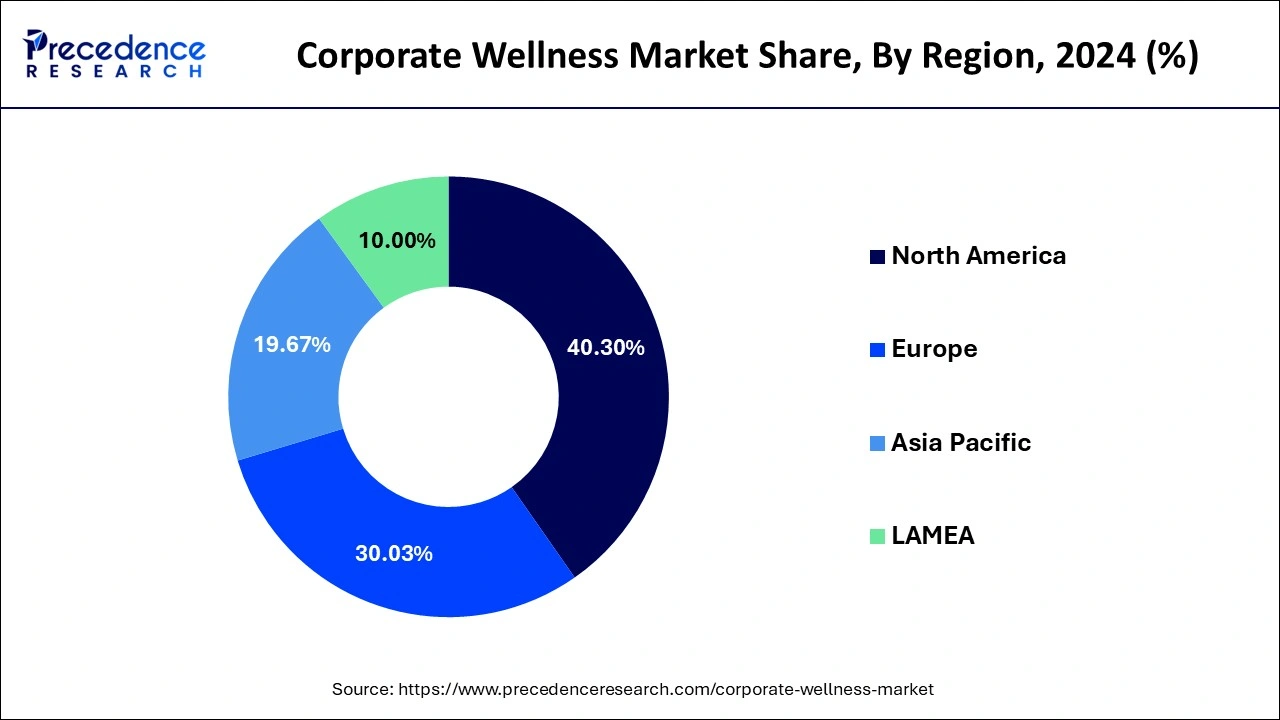
Asia-Pacific Corporate Wellness market is expected to grow strongly in the forecast period as it involves high government initiatives that encourage human resources development. In addition, increase in number of cases of chronic diseases such as cancer and stress disorder is driving the market growth. Moreover, rising aging working-class population in Asia-Pacific region is going to be beneficial for market whereas corporates are spending huge amount on healthcare infrastructure and act as a key opportunity for meeting unmet corporate wellness needs in the region.
In addition, the region offers prominent scope for the western companies to expand their portfolio in the Asian countries, this trend also promote the jobs in the region in turn fuelling the demand for corporate wellness programs significantly.
Europe is observed to grow at a considerable growth rate in the upcoming period. Rising collaboration among research institutions, established players, and EU policies promotes startups, digitization, circular economy practices, and low emission technologies contributing to the growth of the corporate wellness market.
- In March 2025, Wellhub, a leading global corporate wellbeing platform that connects employees with wellness plans across fitness, mindfulness, therapy, nutrition, and sleep and Urban Sports Club, a European provider of corporate employee benefit programs and consumer wellness solutions join forces to meet demand for corporate wellbeing benefits in Europe.
Market Trends
- Rising investment in mental health and stress management programs
- Technologically powered corporate wellness programs
- Rising awareness related to employee health and well-being
- Increasing adoption of corporate wellness programs
Why Latin America held a considerable share of the market?
Latin America held a considerable share of the industry. The growing adoption of wellness therapies by corporate workers in several countries such as Brazil, Argentina, Peru for relaxing from excessive work pressure has boosted the market expansion. Also, the presence of numerous healthcare wellness centers along with rapid investment by large organization for developing mental health of corporate employees is expected to drive the growth of the corporate wellness market in this region.
What made Middle East to hold a notable share of the industry?
Middle East held a notable share of the market. The rising emphasis of corporate companies to adopt AI-based mental care solutions in UAE and South Africa has boosted the market expansion. Additionally, the growing focus of employees to visit meditation centers on regular basis is expected to propel the growth of the corporate wellness market in this region.
Key Players: Taking care of corporate professionals
- Wellness Corporate Solutions: Wellness Corporate Solutions was a company that provided employee wellness programs. The services offered by this company includes biometric screenings, health coaching, and other on-site health services.
- ComPsych:ComPsych is the world's largest provider of Employee Assistance Programs (EAPs), offering a variety of services for both individuals and organizations under its GuidanceResources brand. These services include confidential counseling, work-life support, mental and physical well-being programs, which help employees manage personal and professional issues to improve health, productivity, and retention.
- Provant Health Solutions:Provant Health Solutions was a healthcare services company that specialized in workplace well-being and clinical research support. This company provides on-site, telephonic, and digital services such as biometric screenings, health coaching, and data analytics to help employers manage employee health and costs.
- Beacon Health Options:Beacon Health Options is a behavioral healthcare management company that serves over 40 million people in the United States and provides services to employers, health plans, and government agencies. It is a national leader in mental and emotional well-being, employee assistance programs (EAPs), and crisis services, offering a range of support for both everyday life issues and more challenging conditions.
- Virgin Pulse: Virgin Pulse is a workforce well-being platform that offers a comprehensive suite of digital and live solutions to help companies improve employee health, engagement, and productivity. It provides personalized programs for physical, mental, and emotional well-being, which can include tracking health metrics by offering incentives, and navigating benefits.
- EXOS: EXOS is a high-performance coaching company based in Phoenix, Arizona, founded in 1999. It offers integrated training, nutrition, and physical therapy services to a wide range of clients, from professional athletes and military operators to corporate employees and executives.
Other Key Players
- Marino Wellness
- Vitality Group
- Privia Health
- Central Corporate Wellness
- Wellsource, Inc.
- SOL Wellness
- Truworth Wellness
- ADURO, INC.
- Well Nation
- Fitbit, Inc.
Recent Development
- In October 2025, Lupin launched an AI-enabled wellness platform. This wellness platform is designed for the corporate employees of India.
(Source: health.economictimes.indiatimes.com) - In October 2025, MediBuddy launched Wellness League 3.0. Wellness League 3.0 is a corporate wellness initiative designed for the Indian employees.
(Source: bwhealthcareworld.com) - In September 2025, BetterMe launched BetterMe Business. BetterMe Business is an employee wellness program designed to offer holistic tools to encourage sustainable behavior change among corporate workers.
(Source: prnewswire.com) - In August 2025, to launch AI-powered corporate wellness platform, OneBanc, India's enterprise first neo-banking platform, was entered a strategic partnership with MediBuddy to redefine how corporates manage employee wellness. Corporate India faces fundamental paradox like employee experience needs to be personalized, but personalization is expensive. According to Deloitte's 2024 Gen Z and Millennial Survey, 62% of young employees expect personalized health and wellness benefits.
- In January 2025, to extend an enhanced wellness program for its 75000+ employees and their families Bank of Baroda was partnered with Truworth Wellness. The ‘Employee Assistance Program' (EAP) focuses on mental, emotional, and psychological well-being and offers confidential counselling with experts, covering issues like anxiety and stress.
Segments Covered in the Report
By Service
- Fitness
- Health Risk Assessment
- Health Screening
- Smoking Cessation
- Stress Management
- Nutrition & Weight Management
- Others
By Category
- Psychological Therapists
- Fitness & Nutrition Consultants
- Organizations/Employers
By Delivery Model
- Offsite
- Onsite
By End-use
- Large Scale Organizations
- Medium Scale Organizations
- Small Scale Organizations
By Regional Outlook
- North America
- U.S.
- Canada
- Europe
- U.K.
- Germany
- France
- Asia Pacific
- China
- India
- Japan
- South Korea
- Latin America
- MEA
- Rest of the World
For inquiries regarding discounts, bulk purchases, or customization requests, please contact us at sales@precedenceresearch.com
Frequently Asked Questions
Ask For Sample
No cookie-cutter, only authentic analysis – take the 1st step to become a Precedence Research client



